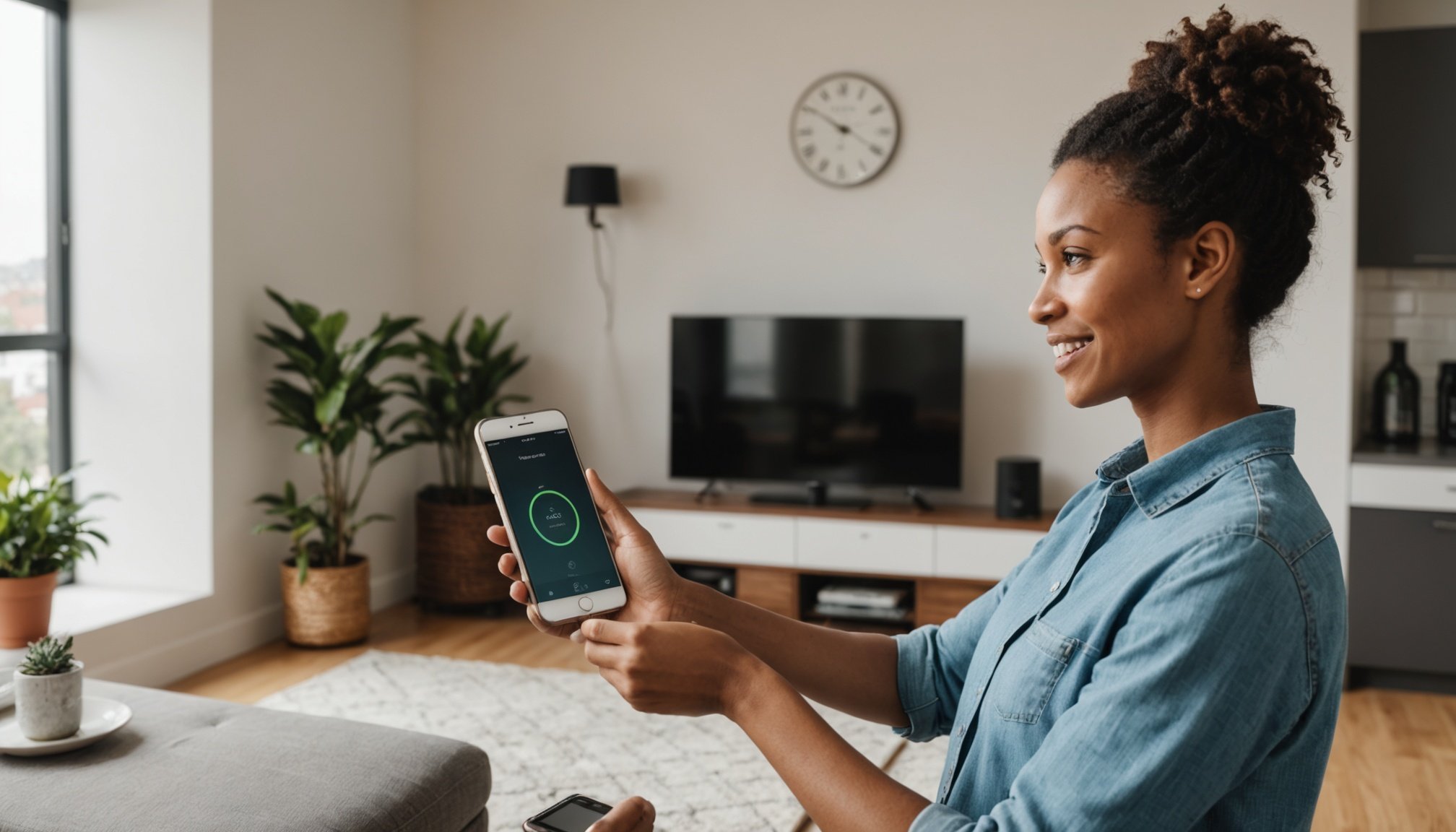Unlock Your Smartphone’s Potential: The Ultimate Guide to Designing and Managing Customized Smart Home Routines
In the era of smart technology, transforming your home into a smart haven is no longer a fantasy but a reality that can significantly enhance your daily life. This guide will walk you through the process of designing and managing customized smart home routines, leveraging the full potential of your smartphone and the latest home automation systems.
Understanding the Basics of Smart Home Automation
Before diving into the nitty-gritty of setting up your smart home, it’s essential to understand the core components and how they work together.
Topic to read : Effortless Smart Irrigation: Take Control of Your Home Watering System with Your Smartphone
What is Smart Home Automation?
Smart home automation involves integrating various devices and systems in your home to be controlled and monitored remotely using your smartphone, voice commands, or a central hub. This technology aims to make your life more convenient, energy-efficient, and secure.
Key Components of a Smart Home
- Smart Devices: These include smart thermostats, lighting systems, security cameras, smart plugs, and appliances that can be controlled via an app or voice commands.
- Hub or Central Controller: Devices like Amazon Alexa, Google Home, or smart home hubs that connect and manage all your smart devices.
- Internet Connectivity: A stable and fast internet connection is crucial for seamless operation of your smart home systems[1][5].
Choosing the Right Ecosystem for Your Smart Home
Selecting the right ecosystem is akin to choosing a common language for all your smart home devices. Here are the major ecosystems and what they offer:
In the same genre : Maximize Your Smartphone’s Capabilities: Your Comprehensive DIY Manual for Creating an Intelligent Home Security System
Amazon Alexa
- Compatibility: Works with a wide range of devices from various brands.
- Voice Control: Alexa’s voice assistant allows you to control your devices with ease.
- Routines: You can set up customized routines that automate multiple tasks with a single voice command[3].
Google Assistant
- Integration: Seamlessly integrates with Google services like Google Calendar and Google Maps.
- Multi-Language Support: Supports multiple languages, making it versatile for different households.
- Smart Home Control: Allows control over a wide array of smart devices through voice commands or the Google Home app[4].
Apple HomeKit
- Security: Known for its robust security features and end-to-end encryption.
- Ease of Use: Simple setup and control through the Home app.
- Compatibility: Works best with Apple devices but also compatible with many third-party devices[5].
Setting Up Your Smart Home Devices
Once you’ve chosen your ecosystem, it’s time to select and set up your smart home devices.
Smart Lighting Systems
- Smart Bulbs: Replace traditional bulbs with smart bulbs like Philips Hue or Eufy Smart Bulbs that can be controlled via your smartphone or voice commands.
- Smart Outlets: Use smart outlets to control existing lighting and other devices.
- Automation Examples:
- Turn off lights when you leave the room.
- Dim lights when watching TV.
- Turn on lights automatically when you arrive home[2].
Smart Thermostats
- Energy Efficiency: Smart thermostats like Nest or Eufy Smart Thermostat can automate temperature control, saving energy and reducing bills.
- Remote Control: Adjust the temperature remotely using your smartphone.
- Automation Examples:
- Set your thermostat to a specific temperature when you leave home.
- Adjust the temperature based on your arrival time[2][4].
Home Security Systems
- Security Cameras: Install wireless security cameras or video doorbells to monitor your home remotely.
- Motion Sensors: Use motion sensors to trigger lights or alerts when motion is detected.
- Automation Examples:
- Turn on security cameras when you leave home.
- Receive notifications when motion is detected[1][2].
Creating Customized Routines and Automations
The real power of smart home technology lies in its ability to automate tasks and create customized routines.
Using IFTTT Applets
IFTTT (If This Then That) allows you to create custom applets that automate tasks based on specific triggers.
- Lights Out: Turn off lights when you leave the room.
- Dim Lights While Watching TV: Dim lights automatically when you start watching TV.
- Turn On All Lights When I Enter: Turn on all lights when you enter a room[2].
Setting Up Routines with Amazon Alexa or Google Assistant
- Morning Routine: Set up a routine that wakes you up with natural light, makes your tea, and reminds you to clean your floor.
- Evening Routine: Create a routine that sets a to-do list for the evening, transitions your lights to warmer tones, and plays relaxing music[3].
Managing Energy Efficiency and Security
Smart home automation is not just about convenience; it also helps in managing energy efficiency and enhancing home security.
Energy Management
- Smart Plugs: Use smart plugs to monitor and control the power usage of appliances.
- Solar Panel Monitoring: Track power generation and consumption using sensors and a Raspberry Pi.
- Automation Examples:
- Turn off appliances when not in use.
- Adjust thermostat settings based on your schedule[4].
Home Security
- Integrate Security Devices: Connect cameras, motion sensors, and smoke alarms to create a comprehensive security system.
- Automation Examples:
- Turn on security cameras when you leave home.
- Receive notifications when motion is detected or when there is an anomaly in your home[2].
Practical Tips and Considerations
When setting up your smart home, here are some practical tips to keep in mind:
Budgeting
- Initial Costs: The cost can range from £200 to £1800 or more depending on the devices and complexity of the setup.
- Long-Term Savings: Smart devices can help you save money on energy bills and enhance the value of your home[1].
Compatibility
- Check Compatibility: Ensure that all your devices are compatible with your chosen ecosystem.
- Protocol Bridging: Use protocols like Zigbee, Z-Wave, or MQTT to integrate devices from different brands[4].
User Experience
- Simplify Control: Use a central hub or app to control all your devices, making it easier to manage your smart home.
- Customization: Set up routines and automations that fit your lifestyle and preferences[5].
Transforming your home into a smart home is a journey that requires careful planning, the right devices, and a bit of creativity. By choosing the right ecosystem, setting up smart devices, creating customized routines, and managing energy efficiency and security, you can unlock the full potential of your smartphone and home technology.
Detailed Bullet Point List: Essential Smart Home Devices
Here is a list of essential smart home devices to consider:
- Smart Speakers:
- Amazon Echo
- Google Home
- Apple HomePod
- Smart Lighting:
- Philips Hue Smart Bulbs
- Eufy Smart Bulbs
- Smart Outlets
- Smart Thermostats:
- Nest Smart Thermostat
- Eufy Smart Thermostat
- Home Security:
- Wireless Security Cameras
- Video Doorbells
- Motion Sensors
- Smart Plugs:
- TP-Link Smart Plugs
- Belkin WeMo Smart Plugs
- Robot Vacuum Cleaners:
- Eufy RoboVac
- iRobot Roomba
- Smart Trash Cans:
- Eufy Smart Trash Can
- Simplehuman Smart Trash Can
Comprehensive Table: Comparing Major Smart Home Ecosystems
| Feature | Amazon Alexa | Google Assistant | Apple HomeKit |
|---|---|---|---|
| Voice Control | Yes, with Alexa | Yes, with Google Assistant | Yes, with Siri |
| Compatibility | Wide range of devices | Wide range of devices | Primarily Apple devices, but compatible with many third-party devices |
| Routines | Customizable routines | Customizable routines | Customizable scenes and automations |
| Security | Robust security features | Robust security features | End-to-end encryption and robust security features |
| Ease of Use | Simple setup and control | Simple setup and control | Simple setup and control through the Home app |
| Integration | Integrates with Amazon services | Integrates with Google services | Integrates with Apple services |
Quotes and Insights
- “Smart home automation is not just about convenience; it’s about creating a more efficient, secure, and enjoyable living space,” says a smart home enthusiast.
- “Using smart thermostats and lighting systems has significantly reduced my energy bills and made my home more comfortable,” notes another user.
- “The key to a successful smart home setup is choosing the right ecosystem and ensuring all your devices are compatible,” advises a smart home expert.
By following these steps and tips, you can create a smart home that is not only convenient but also energy-efficient and secure, all controlled seamlessly from your smartphone.








